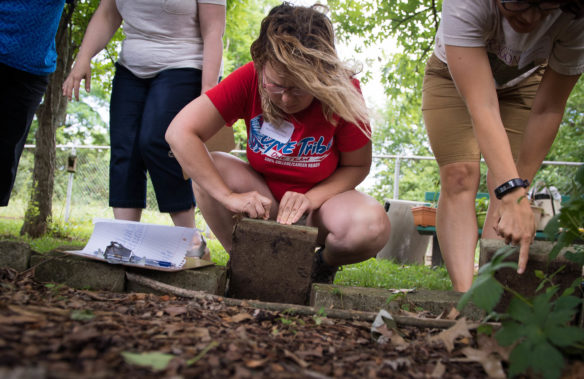
Becca Williams, a teacher at Madison Central High School (Madison County), looks under a rock for wildlife during the outdoor learning symposium.
Photo by Bobby Ellis, June 15, 2017
By Brenna R. Kelly
Brenna.kelly@education.ky.gov
Just days into each new school year, 4th-grade teacher Vivian Bowles takes her students on an unnatural nature hike.
Outside Kit Carson Elementary (Madison County), the students write down the things they see that are part of nature and the things that aren’t.
The trees, the grass, the flowers – nature. The chain-link fence, concrete sidewalk, plastic sundial – not nature.
“I tell them that they are observing, then I tell them to read the list of the things that they classified. I’m throwing in the word classify without even telling them that we were classifying,” Bowles said.
While the lesson is designed to introduce students to the science and engineering process, skills they will be using in science class, it also has a hidden goal – to get the students used to learning outside.
Bowles recently used the activity to show teachers and administrators attending the Kentucky Association for Environmental Education’s (KAEE) first Outdoor Learning Symposium how to use any outdoor space for science instruction.
“An outdoor classroom space doesn’t have to be state of the art,” Bowles said. “In fact, it’s better if it’s not.”
The symposium was designed to show educators how environmental education – and going outside to do it – is a perfect match for the Kentucky Academic Standards for Science, said Ashley Hoffman, KAEE executive director.
The standards call for three-dimensional learning, meaning that students should be doing science rather than simply memorizing facts or theories. Students have to be able to show what they know and can do using three dimensions: science and engineering practices, crosscutting concepts and disciplinary core ideas.
“Environmental education has always been three-dimensional,” Hoffman said. “It’s always been based around phenomena and so we feel like with the science standards, educators really have an opportunity to use environmental education.”
To attend the symposium, educators had to sign up in teams of one teacher and one administrator. The goal was to get more administrators to support teachers’ outdoor learning efforts, she said.
“Teachers can have a hard time taking it back and implementing something schoolwide without administrator buy-in,” Hoffman said. Each team received a $250 grant to use for outdoor learning at their school.

Cynthia Domenghini, an instructor and online Horticultural Therapy program coordinator for Kansas State University, demonstrates plant based-projects that teachers can use in their science classes during the Outdoor Learning Symposium at Kit Carson Elementary (Madison County).
Photo by Bobby Ellis, June 15, 2017
The symposium included sessions using outdoor experiences for literacy lessons, using gardens to build students’ confidence and self-esteem, ways to fund outdoor learning and how outdoor learning can impact assessment.
Brandi Brewer, assistant principal of Augusta Independent School, came to the event hoping to find ways to incorporate the Ohio River into her school’s science instruction. The district’s only school, which serves P-12, is in an 1892 building just blocks from the river.
“We get so used to it, we just take it for granted,” she said. “We have the river and we have that whole ecosystem that goes along with a river. The kids, they know there’s a river, but we don’t use it. We want to find ways we can utilize it.”
The school has a community garden near the Ohio that Brewer hopes to use to teach students about the importance of the river.
“We want show the kids how important of a resource the river is,” she said.
Research has shown that gardening can not only help students understand science concepts, but also can boost students’ self-esteem and confidence, said Cynthia Domenghini, instructor and online Horticultural Therapy program coordinator at Kansas State University, who lead a session about nurturing students using plants
“A lot of students with some difficult behaviors just thrive when you take them outside,” she said.
Domenghini showed teachers that gardening at school doesn’t have to be raised vegetable beds or elaborate pollinator beds. It could be growing lettuce in an open bag of potting soil, growing microgreens that can later be used for a greens taste test or just having the students take care of one plant.
In addition to engaging students, research has shown that environmental education and learning outdoors improves student achievement, increases attendance and improves student health, said Billy Bennett, executive director of the Kentucky Environmental Education Council.
“It’s relevant to the kids. Here it is right in front of them. They can see this phenomenon happening and they want to know why,” he said. “It engages that intrinsic learning mode. They want to explain what they see.”
Bennett, like Bowles, said teachers don’t need an elaborate classroom for outdoor learning.
“Do you have a door to the outside? Then you have an outdoor classroom,” he said.
Amy Dickenson, a teacher at Painted Stone Elementary (Shelby County), said she plans to use something she learned on the unnatural nature hike. Bowles asked the teachers to lift up a paver and check out the bugs underneath.
“That was such a great idea and it’s so simple to make one area with that. I could do that right outside my door,” she said. “Sometimes it’s the simple things we don’t see until we find out about them from someone else.”
In addition to everyday lessons, the teachers also learned how outdoor learning can work with the new science assessment system. The system uses classroom embedded assessments, through-course tasks and summative tests.
“Many of the through-course tasks use phenomenon related to something that could be experienced outdoors, some environmental observable phenomenon,” said Melinda Wilder, education professor and director of Natural Areas at Eastern Kentucky University.
Wilder urged teachers to create an outdoor experience related to one of the through-course tasks to give their students a deeper understanding of the content on which they will be assessed.
“Outdoor phenomenon is a great way to teach a variety of science, whether it’s life science or earth science or physical science,” she said.
Tina Drury, STEM laboratory teacher at Meadowthorpe Elementary (Fayette County), was collecting ideas to incorporate outdoor learning into her class. This past school year, she started a garden club and planted a raised garden bed. She plans to do more raised beds and expand the outdoor learning in her lessons this coming school year.
“I want to encompass the whole gamut of environmental education, not just plants and outdoors, because some kids don’t like that,” Drury said. “Some kids would rather measure light energy or other things.
“I have huge visions.”
MORE INFO …
Ashley Hoffman director@kaee.org
Billy Bennett billy.bennett@ky.gov
Vivian Bowles Vivian.Bowles@madison.kyschools.us






Leave A Comment